If you happen to be in Hyderabad and visiting the iconic Charminar, then don’t hesitate to walk a bit further and pay a visit to the Chowmahalla Palace that is located only at a stone throw distance from Charminar. Initiated in 1750’s and completed between 1857 and 1869, the palace is more than 200 years old and was once the official seat of the Asaf Jahi dynasty. It is today one of Hyderabad’s most popular tourist spots, noted for its stunning architecture and awe-inspiring beauty. With its historical significance and rich heritage, the palace is an irresistible destination for history and art enthusiasts.
The palace’s name directly translates to “Four Palaces.” Chow means four in Urdu, and Mahalat is the plural of Mahalel, which signifies palaces. The majestic palace served as the official residence of the Nizams of Hyderabad during their reign, and it is sometimes compared to the Shah Palace in Tehran, Iran. Even today, the palace is listed as the property of Barkat Ali Khan Mukarram Jah, the Nizams’ heir. UNESCO honoured Chowmahalla Palace with the Asia Pacific Merit Award in 2010.
The palace’s architecture is heavily influenced by Persian, Rajasthani, Indo-Saracenic, and European styles. The complex’s four palaces – Aftab Mahal, Afzal Mahal, Tahniyat Mahal, and Mahtab Mahal – are all a treat for your eyes. Chowmahalla Palace opened to the public in 2005. One part of Chowmahalla Palace is now a museum and library, while another serves as a venue for regal couples to host events.
Post Contents
History of Chowmahalla Palace in Hyderabad
Salabat Jung, the then Nizam of Hyderabad, commissioned the Chowmahalla Palace’s construction in 1750. The construction was finally finished between 1857 and 1869, under the reign of Afzal ad-Dawlah, the fifth Nizam of Hyderabad. This palace became the Nizams’ official residence as well as the venue of their royal court.
Festive celebrations, royal weddings, and welcome parties for royal guests, including Governor Generals, have all taken place here. The Nizams’ accession ceremonies were also held at the Chowmahalla Palace. The palace has two courtyards, as well as the great Khilwat (the Dharbar Hall), fountains, and gardens. The palace originally spanned 45 acres, but just 12 acres remain now. Princess Esra, the wife of Prince Mukarram Jah, renovated the palace over a five-year period, from 2005 to 2010.
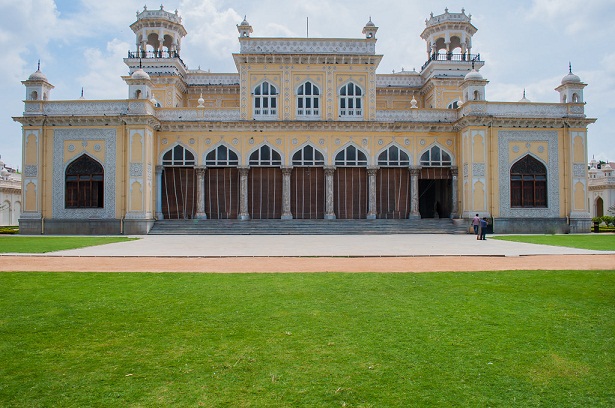
Related Article: Indira Gandhi Rashtriya Manav Sangrahalaya: Showcasing the real and indigenous India
Chowmahalla Palace Architecture
The magnificent Chowmahalla Palace, one of the most famous monuments in Hyderabad, illustrates exquisite architecture. Because of its extended construction period that spanned more than 100 years, the palace reflects diverse architectural influences, including Persian, European, Indo-Saracenic, and Rajasthani styles. It is thought that the structure was inspired by the Shah of Iran’s palace in Tehran. The complex was once spread across 45 acres, but it is now only 12 acres.
Also noted for its fascinating structural architecture, the palace consists of two courtyards, lush gardens, and beautiful fountains. The Southern Courtyard houses the four palaces, hence the name Chowmahalla, which translates as “Four Palaces.” ‘Chow’ is derived from the Hindi term char, which means four, and’mahalla’ means palace. The four palaces are named Afzal Mahal, Aftab Mahal, Mahtab Mahal, and Tahniyat Mahal. Each of these palaces is built in the neoclassical style.
You come across the Bara Imam, a long corridor with a series of rooms that were formerly utilised as the palace complex’s administrative wing which is located in the palace’s Northern Courtyard. Shishe-Alat, which means “mirror image,” is another wonderful structure located opposite the Bara Imam. It has beautiful arches, Mughal-style domes, and ornate stucco work.
The main draw of the Chowmahalla Palace complex however is the magnificent Khilwat or Durbar Hall. The Nizams used to hold their royal court in this ornate pillared hall. Even today, you can see the royal seat, or Takht-e-Nishan, in this hall. The intricately carved motifs that adorn the walls of the palace will leave you awestruck.
Things you must see in the Chowmahalla Palace of Hyderabad
As discussed earlier the Chowmahalla palace can be broadly divided into three parts namely the museum and galleries, the Southern courtyard and the Northern courtyard each are unique in their own ways. Let me take you on a detour of the palace complex.
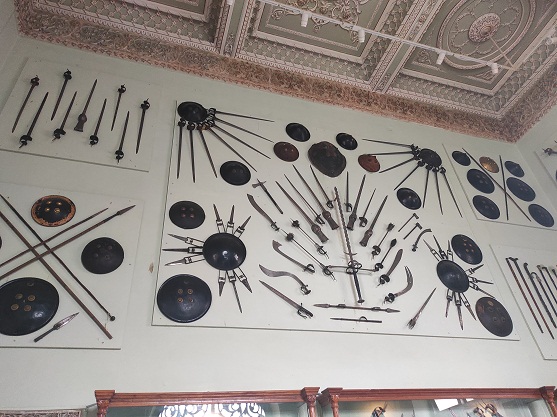
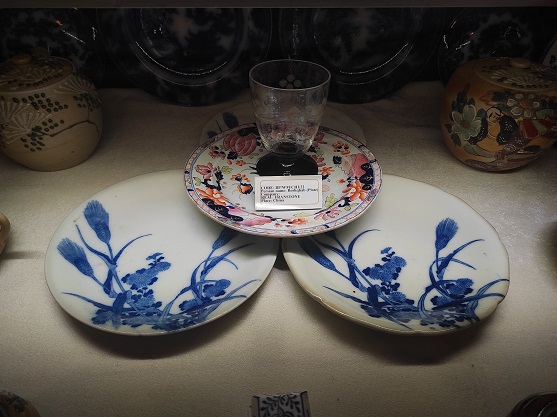
Must Read: Bhojeshwar temple: The unfinished masterpiece of Bhopal
Museum of the Chowmahalla Palace of Hyderabad
You should begin visiting the palace complex with the museum that boasts various galleries with each presenting an interesting display of crockery, clothes, furniture, coins and currency notes, pictures from the Nizam era that are sure to keep you engaged. Display of weapons has been especially done in an interesting manner; these are displayed not just inside glass cabinets but on the walls as well, reaching till the top.
Quran section showcasing Qurans of various kinds such as hand written Quran which has been restored by using Japanese technique, Naskh script, miniature Qurans printed in metal, some which have been inscribed in gold and many others.
The museum also has many galleries presenting an in-depth insight into the personal and political life of Nizams of Hyderabad. The displays are well organised and clearly marked, leaving no room for confusion. Picture galleries have detailed descriptions for each of the image displayed. A must visit when you are in Chowmahalla palace.
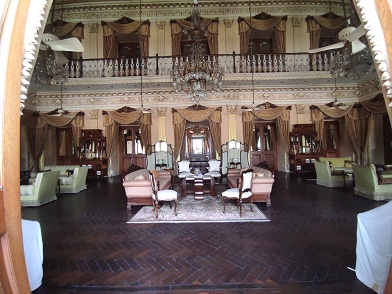
Southern Courtyard of Chowmahalla Palace
This is the oldest part of the palace, and has four palaces namely Afzal Mahal, Mahtab Mahal, Tahniyat Mahal and Aftab Mahal. It was built in the neo-classical style with an elegant display of islamic architecture. The Aftab Mahal is a two storied building and is the biggest of all the four.
Another attraction of the southern courtyard of the Chowmahalla Palace that draws one’s attention is the Afzal Mahal. Entry to this part of the palace is not allowed. However, there are glass windows and a door through which visitors can see it inside. The hall of the palace which has been maintained as it is, shows us the luxuriousness of Nizams lifestyle.
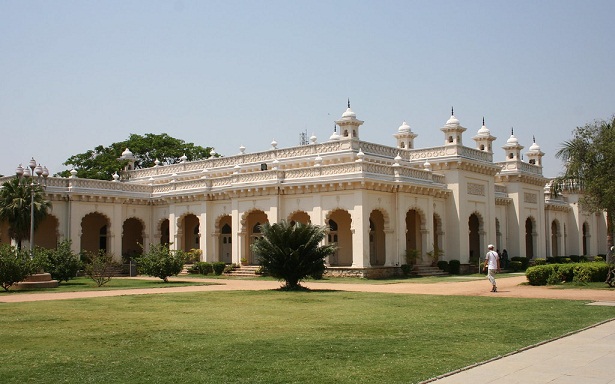
You may also like: Revisiting Bhima Bhoi and Mahima Dharma in Khaliapali
Northern Courtyard of Chowmahalla Palace
This part is called Bara Imam, a long corridor of rooms on the east side facing the central fountain and pool that used to house the administrative wing, and Shishe-Alat, literally means mirror image.
It features Mughal domes and arches, as well as several Persian elements, such as the exquisite stucco work on the Khilwat Mubarak. These were features of structures built in Hyderabad at the time.
A building opposite the Bara Imam is its shishe, or mirror image. Formerly, the rooms were used as guest rooms for officials who accompanied visiting dignitaries.
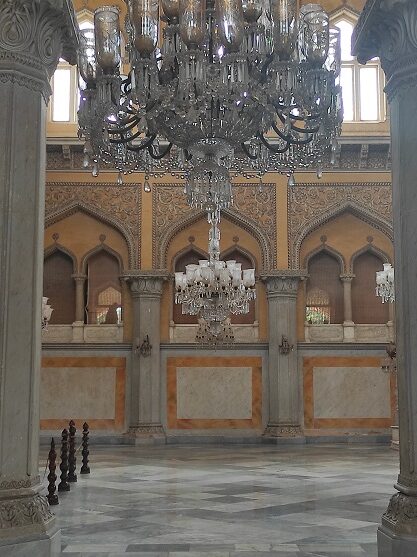
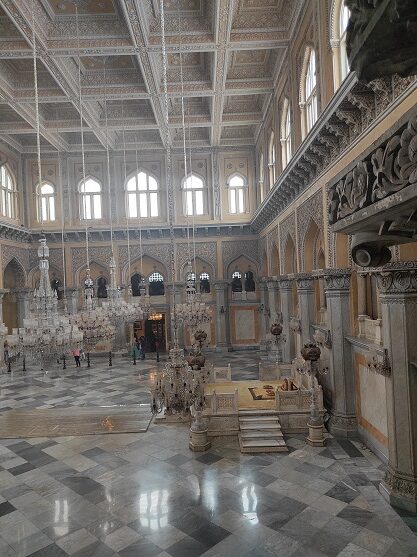
Khilwat Mubarak or Durbar Hall
This is referred to as the heart of the palace and is known as Khilawat Mubarak, and it is the most illustrious portion of this building. With imposing arches, dramatic Mughal domes, and Persian sculpting – the Durbar hall is a true masterpiece in architecture. Inside the hall, there is a platform made of marble on which the royal seat, called Takht-e-Nishan, was laid down.
Delicate carvings, beautiful ceilings, glass chandeliers – the architectural magnificence of the palace needs to be seen to be believed. Because of the splendor and ornate beauty of the palace, it is often compared to the Enchanted Gardens of Arabian Nights
The hall at Khilwat houses the royal seat of the house of Nizam, also known as Takht-e-Nishan. The royal proceedings of the Nizam court would also take place here. Nowadays what attracts a tourist’s attention is that the hall houses a number of Belgian chandeliers.
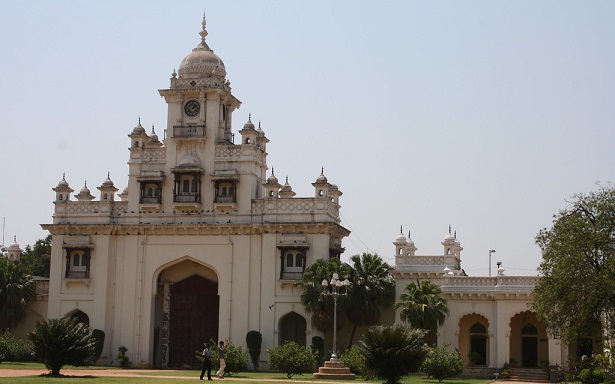
Reccomonded Read: Ellora Cave Monuments: Spirit of co-existance and religious tolerance through rock architectures
Khilwat Clock or Watch Tower
The clock above the main gate to Chowmahalla Palace is called the Khilwat Clock. It has been ticking away for approximately 250 years. Every week, this clock is winded to keep it from not stopping. The people of the locality wait for its chimes and correct their watches by the accuracy of the Khilwat Clock’s timing.
Its upkeep is maintained by an expert family of clock mechanics, who regularly examine the cogs and gears to keep the clock up and running. The structure had sustained some damage due to heavy rain in June, 2020. It has been repaired since then.
Heritage Library in Chowmahalla Palace
The heritage library is the latest addition to the Chowmahalla palace, and it houses nearly 10,000 books. The most precious items in the library include the personal collections of 2 Nizams of Hyderabad – VII Nizam Mir Osman Ali Khan and VI Nizam Mir Mahbub Ali Khan. With a warm and vintage décor, the library is a huge hit among tourists because of its modern furniture, stunning paintings, and realistic portraits that were originally the property of the Nizams.
You can find priceless manuscripts here in various languages, like, English, Persian, Urdu and Arabic. You can also find books that are hundreds of years old on a variety of subjects, like medicine, geography, poetry, Islam, history, and literature.
How to Reach
Chowmahalla Palace is in the heart of the city and is easily accessible via various public transport systems. The Nampally/Hyderabad MMTS bus stop is the nearest. You may simply catch a local bus from the main bus terminal to Nampally because local buses run frequently between the two locations on a regular basis. When you arrive, you can take a cab or an auto rickshaw to the palace. If you want to travel comfortably and don’t mind paying the money, you can take a taxi directly from the bus stop.
Best Time to Visit
Although the palace is open every day except Fridays and national holidays, we recommend visiting during July and October. This is because the weather is much nicer during this time of year, and you will be able to enjoy the lush green palace gardens in all their splendor.
During the summer months, between April and June, the temperature becomes rather hot, making long walks in the palace’s halls and gardens extremely uncomfortable. You are welcome to visit during the winter, but the gardens will not be in bloom.
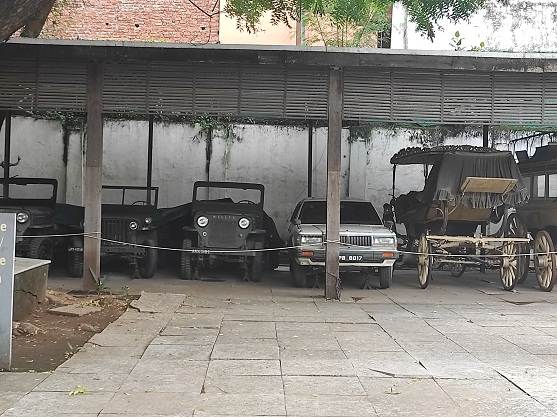
Related post: A trip to the Udayagiri caves near Bhopal
Essential Information
Location : Khilwat, 20-4-236, Motigalli,, Hyderabad, Telangana, 500002, India
Timings : 10 am to 5 pm, open every day except Fridays and national holidays.
Entry fee : The fee is only INR 60 per person if they are of Indian nationality, but for foreigners, the fee is INR 200 per person. The fee for children is only INR 10. And if you want to take in your camera for still photography, you have to pay an extra INR 50. If you want to make videos with a handheld, the extra charge is INR 100.
Note : It should be noted that photography and videography is not allowed in the Quran section of the palace, even if you have paid the extra prices.
Parking Facility : The Chowmahalla palace complex has plenty of facilities for its visitors. Specifically, when it comes to parking, the palace complex has a huge open area right as you enter the main gate. This entire area can be used for parking your vehicles.
Some Interesting Facts about Chowmahalla Palace
- In Persian-Arabic, the name “ Chowmahalla” stands for 4 palaces.
- The palace is believed to be modeled after the palace of the Shah of Iran in Tehran.
- The palace features elements of Persian, Rajasthani, Indo-Saracenic and European styles of architecture.
- Nowadays, the palace has been converted into a museum for displaying exhibits related to its time.
- The southern courtyard features a 1912 Rolls Royce Silver Ghost that was owned by the Nizam.
- The heart of the palace is Khilwat Mubarak and it is one of the most beautiful places in the palace.
- The clock in the Clock Tower has been running for nearly 250 years.
- The palace has 2 courtyards featuring fountains, gardens, and beautiful palaces.
